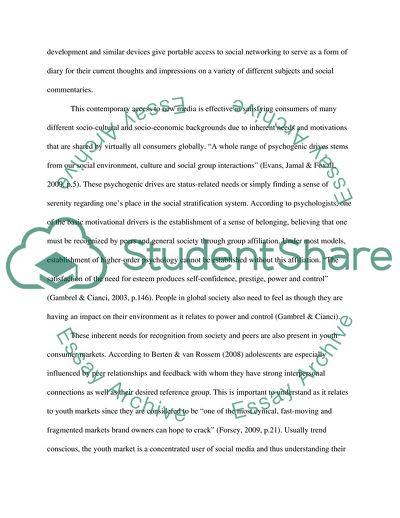Cite this document
(New Media and Consumer Behaviour Coursework Example | Topics and Well Written Essays - 1750 words, n.d.)
New Media and Consumer Behaviour Coursework Example | Topics and Well Written Essays - 1750 words. https://studentshare.org/media/1759621-new-media-and-consumer-behaviour-2000-word-essay-the-growth-in-the-use-of-social-media-has-changed-the-relationship-between-marketers-and-customers-of-brands-some-suggest-that-marketers-have-lost-control-over-their-brands-and-now-have-to-participate
New Media and Consumer Behaviour Coursework Example | Topics and Well Written Essays - 1750 words. https://studentshare.org/media/1759621-new-media-and-consumer-behaviour-2000-word-essay-the-growth-in-the-use-of-social-media-has-changed-the-relationship-between-marketers-and-customers-of-brands-some-suggest-that-marketers-have-lost-control-over-their-brands-and-now-have-to-participate
(New Media and Consumer Behaviour Coursework Example | Topics and Well Written Essays - 1750 Words)
New Media and Consumer Behaviour Coursework Example | Topics and Well Written Essays - 1750 Words. https://studentshare.org/media/1759621-new-media-and-consumer-behaviour-2000-word-essay-the-growth-in-the-use-of-social-media-has-changed-the-relationship-between-marketers-and-customers-of-brands-some-suggest-that-marketers-have-lost-control-over-their-brands-and-now-have-to-participate.
New Media and Consumer Behaviour Coursework Example | Topics and Well Written Essays - 1750 Words. https://studentshare.org/media/1759621-new-media-and-consumer-behaviour-2000-word-essay-the-growth-in-the-use-of-social-media-has-changed-the-relationship-between-marketers-and-customers-of-brands-some-suggest-that-marketers-have-lost-control-over-their-brands-and-now-have-to-participate.
“New Media and Consumer Behaviour Coursework Example | Topics and Well Written Essays - 1750 Words”. https://studentshare.org/media/1759621-new-media-and-consumer-behaviour-2000-word-essay-the-growth-in-the-use-of-social-media-has-changed-the-relationship-between-marketers-and-customers-of-brands-some-suggest-that-marketers-have-lost-control-over-their-brands-and-now-have-to-participate.


